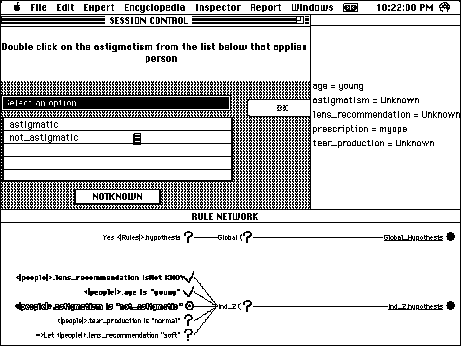
Figure 13 shows the resulting object and rule overviews when the knowledge base described in the previous section is loaded into the shell. The top class and object in the object overview is that defined in Figure 9, the class "people" and the instance of it, "person." The two objects below it are the global and setup hypotheses defined in Figure 10. The lowest class, two sub-classes, and nine instances are the rule classes and rules defined in Figures 8 and 9. The top rule in the rule overview is the top level control rule defined in Figure 10 and the nine rules below it are the ones induced for the contact lens dataset shown in Figure 8 whose definition is exemplified in Figure 11.

Figure 13 Object and rule overviews in NEXPERT
Figure 14 illustrates a consultation with the knowledge base started against a background that shows the object window open at the top right with the values of the instance "person" shown, and the rule window open at the bottom with the top level rule and the first rule shown. Note that everything on this screen has been generated by the knowledge acquisition and expert system tools from the original dataset, including prompt strings, options, test case and rules. In essence the dataset has been compiled in two stages by the two tools to become an expert system. The whole process is automatic and involves no manual editing, although both expert and knowledge engineer can interact to control and modify the compilation as they see fit. The contact lens example is an exceptionally perfect dataset that requires no intervention.

Figure 14 Start of consultation
Figure 15 shows the continuation of the consultation begun in Figure 14. The client clicked "young" in answer to the first question, "myope" in answer to a second question about the prescription, and is now being asked about the astigmatism. As can be seen in the rule window at the bottom, it is actually the first rule that is now being tested.

Figure 15 Part way through a consultation
Figure 16 shows the completion of the consultation when the answers "not astigmatic" and "normal" tear production have been given. The rule shown has been successful and has set the value of lens recommendation to "soft." When this consultation is run with the rules shown rule 5 in Figure 8 is tested first since it is the first one with the highest inference category of 10099. It asks for the age and proceeds only if is "presbyopic." If not, then rule 6 will be tested and, if the age is "pre-presbyopic", it will asks for the prescription. Note that if any of rules 5, 6 or 7 succeed then the value of the lens recommendation will be set to "none" without the value of tear production being requested.

16 Conclusions of consultation
gaines@cpsc.ucalgary.ca 19-Sep-95